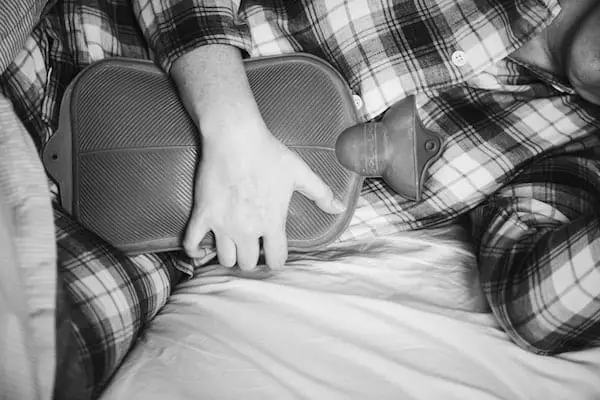About three quarters of people who struggle with acid reflux also experience nighttime acid reflux (source). Nighttime acid reflux will impact the quality of your sleep by making it difficult to fall asleep and stay asleep. If left untreated, nighttime acid reflux can also cause a host of health issues by damaging the esophagus.
The 3 best sleeping positions for acid reflux are on the left side, on the back but elevated, or both on the left side and elevated. All other sleep positions could be potentially hazardous to someone who suffers from acid reflux.
Sleep position is one important way of combating the damage caused by nighttime acid reflux. It works great in conjunction with medication, but in some cases, it can solve the problems you’re having with nighttime acid reflux on its own. Keep reading for more information about how sleep position can improve nighttime acid reflux.

How Does Acid Reflux Affect Sleep?
Acid reflux occurs when the lower esophageal sphincter (LES) does not do its job. The LES should allow food to pass into the stomach and keep it from reentering the esophagus. When the LES doesn’t work properly, it will allow the acidic contents of the stomach to enter the esophagus and cause damage there.
When you are awake and stomach acid enters the esophagus, it creates a painful burning sensation in your stomach and chest, and it may cause a bitter taste in your mouth.
If untreated, acid reflux can cause damage to the esophagus that could lead to more serious health problems like erosive esophagitis, dyspepsia, and esophageal cancer.

When you are asleep, acid reflux will cause you to wake up frequently and prevent you from getting a good night’s sleep. You may wake up coughing if the contents of your stomach reach the back of the throat, and there is risk of aspirating the acid and stomach contents if they flow that far up your esophagus.
The pain and discomfort associated with acid reflux may also prevent you from falling back asleep once it has woken you up.
People with GERD, a serious form of acid reflux, often also have trouble with sleep apnea. It is believed this occurs when acid reflux causes the voice box to spasm and block the person’s airway (source).
In addition, nighttime acid reflux often causes more damage to the esophagus than daytime acid reflux. This is because the stomach acid will sit in the esophagus longer without the assistance of gravity to pull the stomach acid back into the stomach.
Additionally, when we are awake, swallowing saliva, something we do without even thinking about it, will also help send the stomach acid back where it belongs. When we sleep, saliva production slows down, and we swallow less frequently.
Essentially, when we are awake, acid reflux generally enters the esophagus and goes back into the stomach quickly. When we sleep, the acid reflux enters the esophagus and lingers there causing more damage and putting you at greater risk of more health issues.
Best Sleeping Positions for Acid Reflux

The position that you sleep in can have a huge impact on how often you experience acid reflux while you are sleeping. The best positions will allow gravity to help with the flow of stomach acid and will not put unnecessary pressure on the stomach.
Changing your sleep position is easier said than done if you already have a long-standing favorite position. It takes time and patience to alter your sleep position, but it can be done.
1. Sleep on Your Left Side
At first thought, you would not think that sleeping on your side would influence acid reflux at all. It doesn’t make it easier for gravity to pull the contents of the stomach away from the esophagus, after all, but it makes a significant difference.
Researches do not agree on why this is the case, but the studies that have been done all say the same thing. Lying on your left side will help with acid reflux at night.
Some researchers believe sleeping on your left side helps because the location where the stomach and the esophagus meet is higher than the contents of the stomach when laying in this position.
Other researchers believe that sleeping on the right side causes the LES to relax, which would allow more of the contents of your stomach to flow through the LES and to the esophagus. Sleeping on the left side does not cause the LES to relax, so it can still keep stomach contents out of the esophagus.
Still others think that sleeping on the left side allows food to exit the stomach more quickly, and an emptier stomach is less likely to cause an acid reflux incident.
Perhaps it is a combination of all three of these things, but no matter the reason, the research is clear and persuasive that you are better of sleeping on your left side than any other sleep position.
2. Sleep with your Entire Torso Elevated
One of the most commonly given pieces of advice to people who suffer from nighttime acid reflux is to sleep elevated. This is because elevating the torso will allow gravity to pull the contents of your stomach away from the LES, and it works.
Luckily, you don’t need to sleep sitting straight up, just at an angle. There are several ways you can go about achieving this angle and one you should avoid.
Bed Risers
When first told they need to sleep in an elevated position, many people first turn to bed risers. Bed risers are small, typically inexpensive plastic blocks that are used to raise a bed.
To use for acid reflux, you can put under the feet of your bed by the headboard. This will raise the head of your bed in relation to the lower part of your bed.
Most bed risers are not designed for this use and some beds frames will not do well at an angle like this. It may work well for some beds, but it is not the most stable option for elevating one side of your bed.
Wedge Pillow
Wedge pillows are exactly what they sound like. They are a pillow shaped like a wedge. Wedge pillows tend to be firmer than typical pillows so that many people use a second traditional pillow on top of the wedge.
Wedge pillows are also usually large as they need to support the entire torso and put it at an angle, which is what is needed to help with nighttime acid reflux. If you only elevate your head, it won’t help the angle of your esophagus and stomach at all.
For the best results, the wedge should be between 6 and 10 inches high at the head of the bed, and the angle should start at your hips and gradually increase all the way up to your head.
Mattress Elevator
An alternative to the pillow wedge is the mattress elevator. A mattress elevator is similar to a pillow wedge, but it goes between your mattress and box spring and runs the length of your entire bed.
This is a little more comfortable for some people who don’t like the feel of sleeping directly on the wedge because mattress elevators create a more gradual angle.
In addition, the mattress elevator will put anyone you share your bed with at an angle. If your partner isn’t interested in sleeping with their torso elevated, this might not be the solution for you.
Adjustable Bed
You may not want to go out and buy a whole new bed, but one of the best ways of sleeping at an angle is to get an adjustable bed. Adjustable beds have a base that can be moved to elevate the torso, your feet, or both.
Most adjustable bed bases raise the head of the bed while leaving the rest of the bed flat, but some tip the entire bed. Make sure you choose a model that suits your needs and try before you buy, if possible.
Adjustable beds are especially nice if you share a bed with someone who does not struggle with acid reflux and who finds it difficult to sleep at an angle. An adjustable bed with a split base and mattress would give you the angle you need without disturbing your partner.
AVOID The Pillow Mountain
Some people try to simulate a wedge pillow piling several pillows underneath them until their torso is at an angle.
While the pillow mountain method can work in theory, it is difficult to maintain a consistent angle that will stay in place throughout the night. It will also require an awful lot of pillows as the angle should start at your hips and increase as it moves toward the head of your bed.
Sleeping on a pile of lumpy pillows doesn’t sound all that appealing anyway.
3. Sleep Elevated and On Your Left Side
The ultimate sleep position for help with nighttime acid reflux is to sleep with your torso elevated and on your left side.
If you can prevent nighttime acid reflux by sleeping on your left side and sleeping with your torso elevated, it is no surprise that doing both at the same time should be even more effective.
Pillow systems like the MedCline Pillow System are designed to help people sleep comfortably on their sides and at an angle. These pillows even have a hole in the wedge that you can slip your arm through if you tend to sleep with your arm under you, and some of them come with a body pillow that helps you get the same deep pressure you would get when you sleep on your stomach.
Sleep Positions to Avoid

Now that you know the positions you should sleep in, I will explore the positions you should avoid because they increase the likelihood of you experiencing acid reflux.
This article is owned by Sleeping Report and was first published on July 6, 2019
Sleeping on Your Back
Many people prefer to sleep on their backs and when you don’t struggle with acid reflux, it is not a bad position as it doesn’t put extra stress on your spine. But when you have problems with acid reflux, sleeping flat on your back will definitely cause you problems.
Sleeping on your back does not allow gravity to help keep your stomach acid away from the LES and in the bottom of your stomach, and perhaps even worse, once the refluxed contents of your stomach enter the esophagus, they will stay there longer.
The contents will sit in the esophagus longer because gravity will not pull it down, but also because at night you do not swallow as often, and salvia will therefore not help push the refluxed stomach acid back into the stomach.
Sleeping on your back is even more of a problem if you have excess belly fat as gravity will be pulling that fat and squishing it into your stomach. The pressure could cause the contents of your stomach to be pushed through the LES.
Sleeping on Your Stomach
Sleeping on your stomach is not a good sleeping position regardless of acid reflux because it puts extra stress on your back and neck, but it is even worse for you when you have acid reflux.
Sleeping on your stomach is not good if you have acid reflux for all the same reasons that sleeping on your back is not good for it. You lose the help of gravity in keeping your stomach contents where they belong.
In addition, sleeping on your stomach puts pressure on your stomach which could cause acid to more easily flow into the esophagus.
Sleep Position Babies with Acid Reflux

Babies commonly have issues with acid reflux because their lower esophageal sphincter is still developing, and it does not do a great job of keeping the contents of the stomach from being regurgitated. This is part of the reason why babies spit up.
Most of the time spit up is a completely normal and an expected part of feeding a baby. Most babies are completely unperturbed by spitting up, but some babies experience painful symptoms associated with feeding, and these babies could have reflux issues.
The best sleep position for a baby with reflux is different from that of an adult. A baby should always be put to sleep on its back without anything else in their crib because it has been shown to be effective at preventing SIDS.
If a baby has reflux issues, a doctor will typically recommend allowing the baby to sleep with their torso elevated in their crib to help with nighttime reflux problems.
Do not use a pillow or a sleep positioner to elevate the baby as they have been shown to increase the risk of SIDS. Sleep positioners may claim that they reduce the risk of SIDS, but the FDA has not approved any of these statements, and they are often unfounded.
The best way to provide elevation for an infant is to elevate the mattress from underneath. Only do this if it is a recommended solution given to you by your doctor.
The good news is that most babies grow out of their reflux issues by the time they are 12 months old and as their LES matures. There are other methods of reducing acid reflux in babies who are experiencing issues with it besides sleep position.
Other Methods of Preventing Acid Reflux While Sleeping

Using an optimal sleep position is the most effective way of stopping acid reflux from waking you in the middle of the night, but it is not the only solution. If you’re still experiencing nighttime acid reflux, there are some other things you can do.
This article is owned by Sleeping Report and was first published on July 6, 2019
Avoid Tight Pajamas
If you wear tight fitted pajamas, especially pajamas that put pressure on your waist, you could experience more acid reflux symptoms. Any pressure placed on the stomach by pajamas or anything else can cause acid to be pushed into your esophagus.
If you’re still experiencing nighttime acid reflux after changing your sleep position, make sure your waist band isn’t too tight, and may invest in a fresh pair of PJs.
Don’t Eat Before Bed
To help prevent nighttime acid reflux incidents, make sure you give your food plenty of time to digest before you lay down in bed. You should give your stomach 3 to 4 hours after you eat to digest your food before going to bed.
The fuller your stomach is when you lay down to go to sleep, the more likely it is that you will have trouble with acid reflux. It is recommended you eat your biggest meal at lunch and a smaller dinner to allow your food plenty of time to digest before you go to bed.
Take Your Medication
If changing your sleep position and other lifestyle changes do not solve your nighttime acid reflux issues, then you should talk to your doctor about getting a medication you can take to help you avoid damaging your esophagus.
SleepingReport.com copyright article was updated on ..
The damage stomach acid can cause to your esophagus can lead to serious health problems if it is not stopped. Take your heartburn seriously and talk to your doctor about it.

